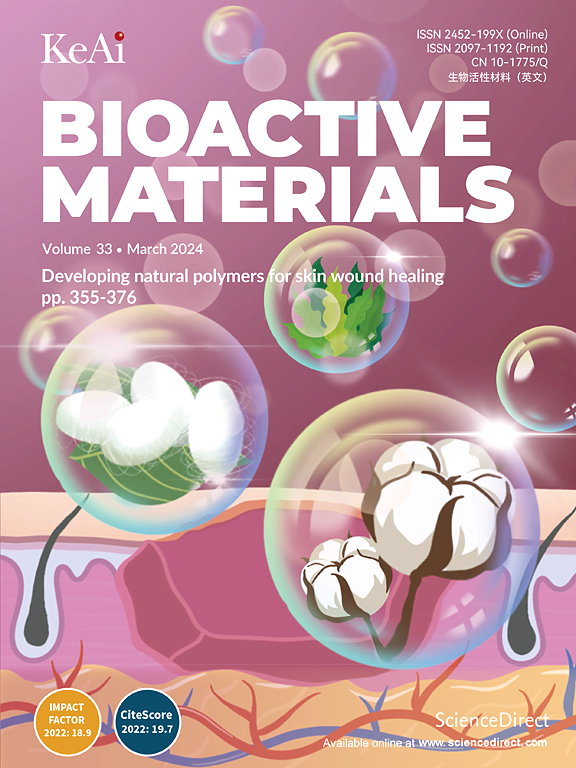金属酚网络通过诱导氧化和蛋白毒性应激特异性地消除缺氧肿瘤
IF 18
1区 医学
Q1 ENGINEERING, BIOMEDICAL
引用次数: 0
摘要
缺氧是实体瘤的普遍特征,严重损害了癌症治疗的效果。然而,目前临床上还没有可行的治疗缺氧肿瘤的方法。在这里,我们开发金属酚网络(CuGI)利用天然糖酵解抑制剂(表没食子儿茶素没食子酸酯)和人体必需的金属元素(铜离子),专门针对和消灭缺氧的癌细胞。CuGI将缺氧癌细胞的代谢途径从厌氧糖酵解重定向到氧化磷酸化,从而增强活性氧的产生,促进三羧酸循环中脂酰化蛋白的低聚化。通过靶向诱导氧化和蛋白毒性应激,CuGI在缺氧条件下特异性诱导癌细胞凋亡和铜坏死,而不影响正常细胞。此外,癌细胞膜包被的CuGI (CuGI@CM)表现出增强的肿瘤穿透作用和良好的生物相容性,有效抑制结直肠肿瘤的生长。重要的是,CuGI@CM,当与血管干扰物或加重肿瘤缺氧的放疗联合使用时,协同增强了治疗效果。因此,CuGI代表了一种特异性和有效的纳米疗法,能够选择性地消除缺氧肿瘤,为解决肿瘤缺氧的联合治疗提供了希望。本文章由计算机程序翻译,如有差异,请以英文原文为准。

Metal-phenolic networks specifically eliminate hypoxic tumors by instigating oxidative and proteotoxic stresses
Hypoxia, a prevalent characteristic of solid tumors, substantially impairs the efficacy of cancer treatments. However, there are no feasible clinical approaches for treating hypoxic tumors. Here, we develop metal-phenolic networks (CuGI) utilizing the natural glycolysis inhibitor (epigallocatechin gallate) and the essential metal element in the human body (copper ions), specifically targeting and annihilating hypoxic cancer cells. CuGI redirects the metabolic pathway of hypoxic cancer cells from anaerobic glycolysis to oxidative phosphorylation, thereby enhancing reactive oxygen species production and promoting oligomerization of lipoylated proteins in the tricarboxylic acid cycle. Through targeted induction of oxidative and proteotoxic stresses, CuGI induces apoptosis and cuproptosis specifically in cancer cells under hypoxic conditions while sparing normal cells. Moreover, cancer cell membrane-coated CuGI (CuGI@CM) exhibits enhanced tumor penetration effect and demonstrates commendable biocompatibility, effectively suppressing colorectal tumor growth. Importantly, CuGI@CM, when combined with vascular disruptors or radiotherapy which aggravate tumor hypoxia, synergistically potentiates therapeutic efficacy. Thus, CuGI represents a specific and potent nanotherapeutic capable of selectively eliminating hypoxic tumors, offering promise in combination therapies to address tumor hypoxia.
求助全文
通过发布文献求助,成功后即可免费获取论文全文。
去求助
来源期刊

Bioactive Materials
Biochemistry, Genetics and Molecular Biology-Biotechnology
CiteScore
28.00
自引率
6.30%
发文量
436
审稿时长
20 days
期刊介绍:
Bioactive Materials is a peer-reviewed research publication that focuses on advancements in bioactive materials. The journal accepts research papers, reviews, and rapid communications in the field of next-generation biomaterials that interact with cells, tissues, and organs in various living organisms.
The primary goal of Bioactive Materials is to promote the science and engineering of biomaterials that exhibit adaptiveness to the biological environment. These materials are specifically designed to stimulate or direct appropriate cell and tissue responses or regulate interactions with microorganisms.
The journal covers a wide range of bioactive materials, including those that are engineered or designed in terms of their physical form (e.g. particulate, fiber), topology (e.g. porosity, surface roughness), or dimensions (ranging from macro to nano-scales). Contributions are sought from the following categories of bioactive materials:
Bioactive metals and alloys
Bioactive inorganics: ceramics, glasses, and carbon-based materials
Bioactive polymers and gels
Bioactive materials derived from natural sources
Bioactive composites
These materials find applications in human and veterinary medicine, such as implants, tissue engineering scaffolds, cell/drug/gene carriers, as well as imaging and sensing devices.
 求助内容:
求助内容: 应助结果提醒方式:
应助结果提醒方式:


